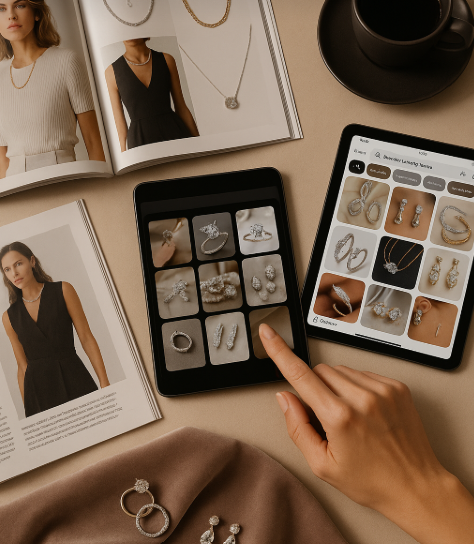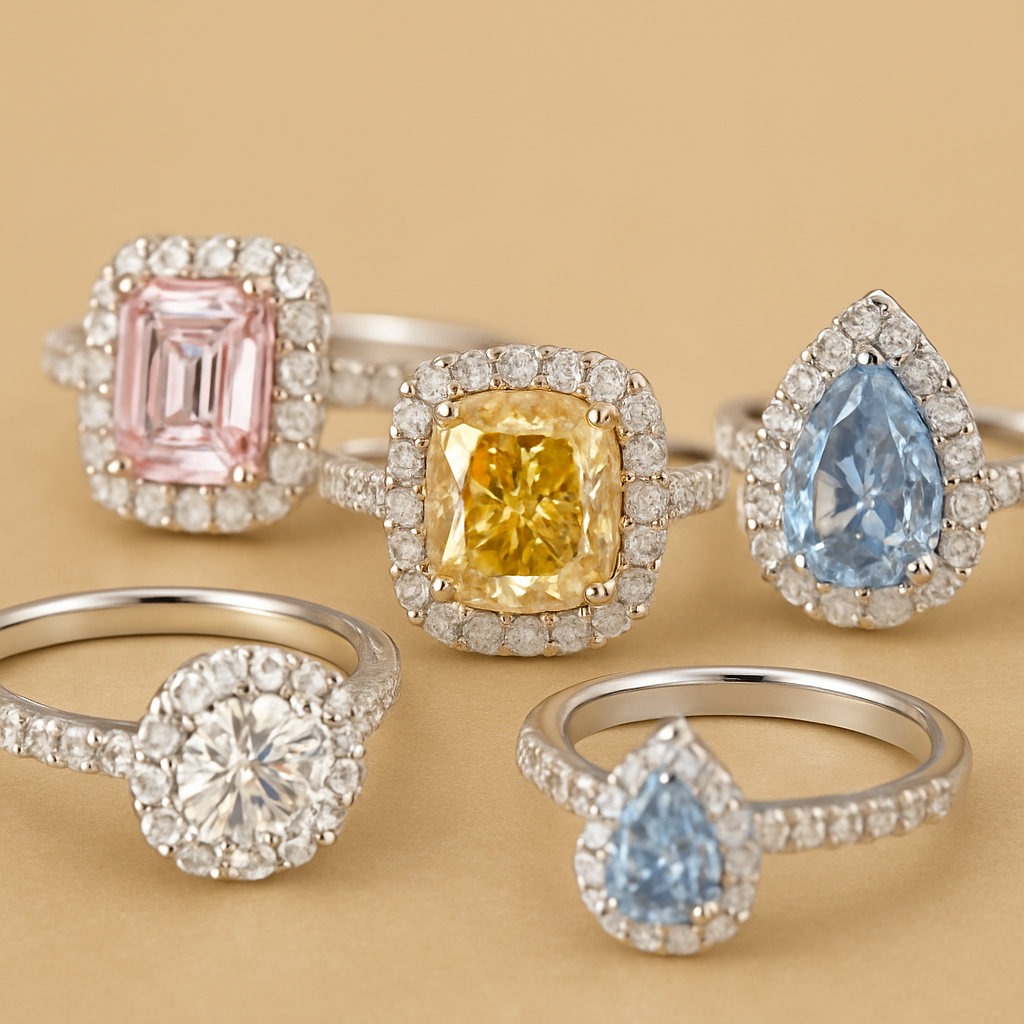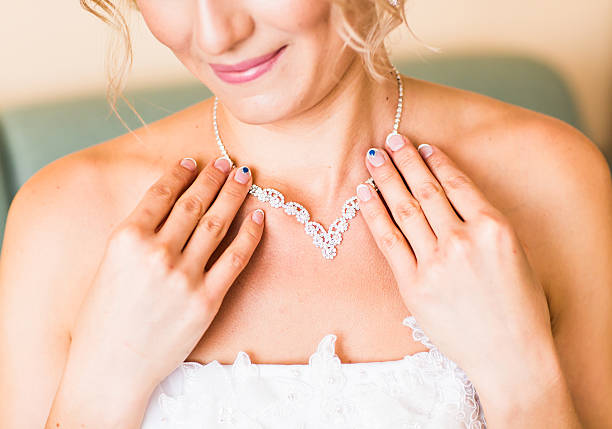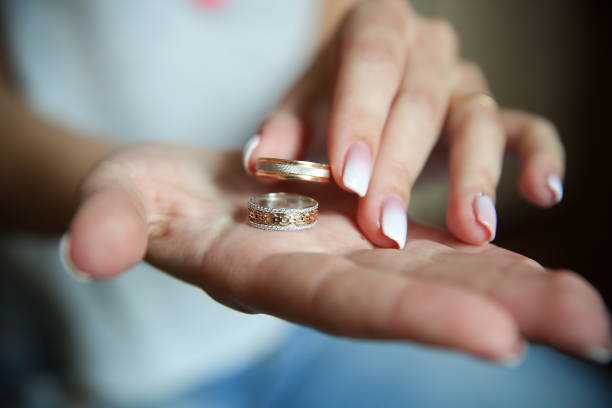The diamond jewelry world is forever changing—what was last season's dazzle can be passé this season. If you're a jewelry connoisseur, brand manager, stylist, or just someone who loves to be in the know, following current trends makes you shop or design smarter, generate content that is relevant, and build ageless collections with a fashion twist.
So how do you successfully monitor what's hot in diamond jewelry—without getting caught in the noise? Let's break it down step by step across digital media, industry trends, celebrity culture, real-world observation, and data analytic tools.
1. Follow Global & Niche Jewelry Trend Forecasting Platforms🌐
Situation: You wish to anticipate changes in gemstone shapes, metal colors, settings, and customer preferences for the next one to two years.
- Make use of high-end resources such as TrendVision Jewellery + Forecasting, The Future Laboratory, and WGSN. Based on generational behavior, economic shifts, and emotional trends, these offer in-depth research on not only what is trending but also why.
- An affordable substitute: Keep up with reports on JCK Online, The Jewelry Editor, and National Jeweler, which offer free insights based on events or seasons.
- Trend example: Long before they became popular, these platforms foresaw the emergence of lab-grown stones, stacking bands, and gender-fluid jewelry.
Pro Tip: Save their yearly "Jewelry Trend Forecast" PDFs to your bookmarks and compare them to your own design calendar.
📱 2. Use Instagram, TikTok & Pinterest as Real-Time Trend Barometers
Scenario: You want to know what's trending now—what people are posting, purchasing, or wearing right now.
-
Monitor trending hashtags:
#DiamondJewelry #StackedRings #ToiEtMoiRing #LabGrownDiamonds #StatementEarrings - Watch influencer trends: Micro-influencers tend to begin niche trends such as pinkie rings, floating diamonds, or pear-cut accents before larger accounts pick them up.
- Pinterest is treasure trove for seasonal outlook: Search boards such as "2025 Wedding Jewelry Trends" or "Minimalist Diamond Styles."
Cultural Observations: TikTok has brought back retro cuts such as Asscher and Marquise among Gen Z consumers who seek "anti-basic" diamond styles.
📸 3. Analyze Red Carpet & Celebrity Moments
Situation: You want your item to feel both iconic and on trend, whether you're creating a new collection or buying for a special occasion.
- To see next-season pieces, jewelry stylists frequently collaborate with major houses like Cartier, Chopard, or Bulgari. Keep an eye on high-profile events like the Oscars, Grammys, and Met Gala.
- Keep an eye out for design repetition. Do celebrities wear necklaces in layers? Is there a resurgence of bold chokers?
- Mass movements are frequently produced by star engagement trends. (For example, Hailey Bieber's oval-cut solitaire with a hidden halo or Megan Fox's Toi et Moi ring.)
Advice: For in-depth analyses of jewelry styling, consult the archives of Vogue Runway or Getty Images.
🛍️ 4. Monitor High-End Retailers & Fine Jewelry Launches
Scenario: You need to know which commercial styles are on the rise—what's being made, purchased, and reordered.
- Brands such as Tiffany & Co., Blue Nile, James Allen, and Brilliant Earth regularly refresh "New Arrivals" sections. Check every week.
- Make note of:
- Metals (yellow gold comeback?)
- Stone shapes (pear, emerald, Asscher, radiant)
- Band types (open bands, bypass settings, tension rings)
Designer Strategy: Trends are quietly tried out by brands—check capsule collections, celeb collaborations, or "editor's picks" to observe what they're taking a risk on.
📈 5. Leverage Google Trends, Exploding Topics & Analytics

Situation: You need to know what the market is looking for because you're launching a product or starting a blog.
- To compare search interest, use Google Trends. Compare the "Oval Diamond Ring" and the "Princess Cut Ring," for instance.
- Use resources such as Ubersuggest, AnswerThePublic, and Exploding Topics to examine search activity for terms such as:
- "Lab diamond rings under $1000"
- "Ethical rings for engagement"
- "The return of the tennis bracelet"
Data tip: Before the market becomes saturated, look for long-tail keywords that are gaining traction.
🧵 6. Join Jewelry Forums & Subreddits
Scenario: You seek genuine, unbiased feedback from genuine consumers and aficionados—not only brand promotion.
- Scan subreddits such as:
- r/jewelry
- r/EngagementRings
- r/LabGrownDiamonds
- From "Is yellow gold making a comeback?" to "Will pear cuts go out of style?" with genuine, real-life images and feedback.
- You can also pose questions, conduct surveys, or pilot trend forecasts.
Example: A photo post revealing a secret halo setting received 2K+ upvotes on Reddit before becoming a best seller on Etsy and Amazon.
🧭 7. Read Fashion Week Recaps and Lookbooks
Scenario: You desire artistic, high-fashion inspiration to create or identify luxury diamond trends that can trickle down.
- Examine Paris, Milan, New York, and London Fashion Week jewelry styling.
Primary sources: Vogue, Elle, InStyle, WWD - Designers such as Schiaparelli, Balmain, and Dior tend to showcase avant-garde jewelry that makes its way into street style months afterward.
- Notice:
- Earring silhouettes (cuffs vs chandeliers)
- Ring placement (middle finger stacking, pinkie rings)
- Necklace layering styles
Design Shift Example: Large geometric diamond pieces spotted at Couture Paris shows subsequently influenced minimalist hexagon solitaire settings.
🧑🎓 8. Enroll in Jewelry Design Workshops or Attend Trade Shows
Situation: You own a brand or are a designer who wants to know what trends are before they are made public.
- Attend occasions such as:
- Las Vegas's JCK
- Italy's Vicenzaoro
- Fashion Show
- Modules on buyer psychology, forecasting, and market trends are common in GIA, IGI, and Jewelers of America workshops.
Brand Growth Tip: By networking here, you can learn about upcoming materials like moissanite hybrids or AI-assisted diamond cuts, as well as global trends and supply issues in the industry.
🛒 9. Track Local Boutique Sales and Consumer Feedback
Scenario: You're an entrepreneur or enthusiast interested in local trends or actual preferences.
- Shop at upscale boutiques and department store counters. Ask what's moving the quickest.
- See what buyers try on, return, or purchase in-store. Are they opting for retro cuts? Delicate everyday items?
- You might also see cultural changes—such as a demand for mangalsutra-style designs, or fusion items for South Asian weddings.
Trend Insight: Occasionally, local tastes go national (e.g., Indian-inspired choker layering trended on TikTok in the US.).
♻️ 10. Watch the Revival of Vintage & Heirloom Styles
Situation: You're looking for classic ideas that complement the prevailing design fads that are fueled by nostalgia.
- Keep an eye on resale sites such as Etsy Vintage, 1stDibs, and The RealReal.
- Examine jewelry from:
- 1920s–30s Art Deco
- Modern Mid-Century (1950s–70s)
- Y2K Revival (heart pendants, tennis chains, and bling from the 2000s)
Creative Tip: Think about combining traditional themes with contemporary morals, such as recycled-gold vintage-inspired earrings or lab-grown Art Deco cocktail rings.
💎 Final Thoughts
Understanding the history of shifting consumer values, artistic expression, and tastes is more important than simply copying the newest trends in diamond jewelry.
Using trend-tracking tools lets you stay creative while respecting classic elegance, whether you're styling for yourself or creating a brand like San Liora. Always let your intuition lead your sparkle, and keep one eye on the numbers and the other on beauty.







